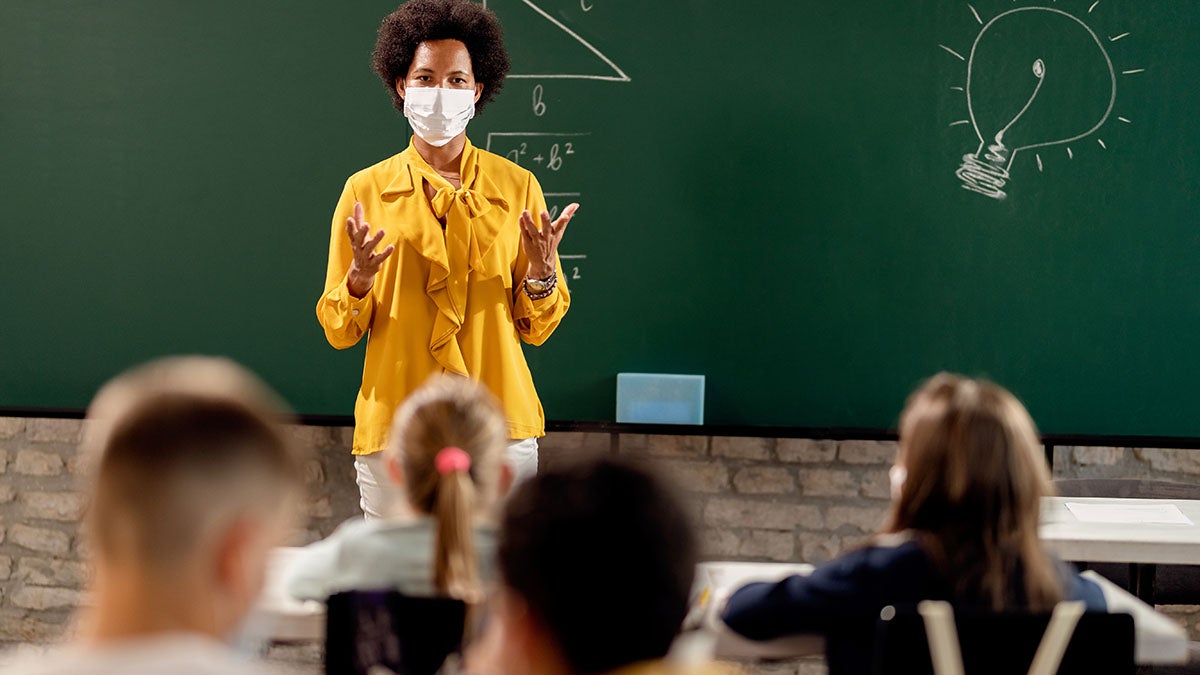 Teacher standing in front of her class
Teacher standing in front of her class
COVID-19 shuttered schools around the world, leaving more than 1.6 billion children out of school early in the pandemic. According to a recent UNICEF calculation, approximately 214 million children – or 1 in 7 globally – missed over three-quarters of in-person learning between March 2020 and February 2021.
While most countries have reopened schools for some in-person instruction, subsequent COVID19 outbreaks have prompted lockdowns and more closures, suggesting that the recovery of learning is likely to involve schools’ switching between episodes of school reopening and closing.
The ensuing expected learning losses would translate into a rise in the global Learning Poverty rate to 63% (from 53% before COVID-19).
What can governments do to ensure that children return to school safely and stem learning losses they may have sustained?
UNICEF, UNESCO, the World Bank, and the World Food Programme published a joint Framework for reopening schools that provides high-level guidance around safe operations, stemming learning loss, ensuring the well-being of students and teachers, and guidance on how to reach the most marginalized children.
What have we learned so far about how countries should implement these recommendations? What specific investments, actions, and programs can help?
To support countries’ reopening efforts, our team at the Bank’s education Global Practice has developed a package of short Policy Action Notes that curate evidence and examples around essential policy actions and provide choices for different contexts during both remote and in-person instruction. By design, the Notes are short and are meant to be “living documents” that offer a starting point for implementing recommendations related to health and safety, modifications to education systems’ pedagogical approaches, and management of the reopening process, covering needs and responsibilities of various stakeholders (students, teachers, parents, school management).
Within these three broad buckets – health and safety, pedagogical, and managerial – we have identified a set of key policy actions countries may want to consider as they strive to bring children back to school:
Health and Safety
- When is it safe to reopen schools? This note describes the parameters countries should monitor to make an evidence-based decision regarding reopening schools.
- How can we minimize disease transmission in schools? This note provides evidence on mitigation strategies that can help reduce transmission within schools.
Modifying Pedagogy
- What are the options for restructuring the academic calendar to address learning loss and support student well-being? This note describes ways to generate more instructional time to regain lost learning and offers advice on how to prepare for future shutdowns.
- How can the curriculum be adapted to address student and teacher needs? This note examines how countries can prioritize core subjects and incorporate social-emotional learning into the curriculum, and also help teachers by providing modified detailed lesson plans.
- Which strategies encourage re-enrollment of vulnerable students? Many countries will find it challenging to ensure that all students, especially girls, refugees, and other vulnerable populations, return to school. This note presents approaches that countries can adopt to encourage re-enrollment of these groups.
- How can countries prepare and support teachers? The pandemic has substantially increased demands on teachers and has increased the complexity of their jobs. This note offers guidance on how countries can re-engage teachers and improve their well-being to enhance their effectiveness post-pandemic.
- What can countries do to support learning at home? Remote instruction has taken many forms. This note describes how learning at home strategies can continue after schools reopen to mitigate learning losses, as well as how to identify students who may have been exposed to abuse and neglect during school closures.
- How should countries approach learning assessments and exams? This note discusses how learning assessments can help teachers, schools, and education systems identify learning needs to reduce learning losses. To ensure safety and give every child equal opportunity, education systems can also modify or eliminate high-stakes examinations.
- What remedial education options are available? This note describes how teaching students at their own level can help them stem learning losses and catch up to grade-level standards, as well as other strategies that have been found to improve student learning in various contexts.
Management
- How can countries prepare and support school leaders? School administrators have taken on substantial additional responsibilities during the pandemic. This note identifies ways countries can empower and assist school leaders during reopening process.
- What strategies help communication with stakeholders? Communication has been a key element of effective COVID-19 response. This note summarizes good practice on how, when, and what to communicate to different stakeholders.
These Reopening Notes were produced in line with the Mission: Recovering Education 2021 by which the Bank is partnering with UNESCO and UNICEF to support countries as they take all actions possible to plan, prioritize, and ensure that all learners are back in school; that schools take all measures to reopen safely; that students receive effective remedial learning and comprehensive services to help recover learning losses and improve overall welfare; and their teachers are prepared and supported to meet their learning needs.
The Reopening Notes were developed through a rigorous process of curating policy options, including reviewing the literature and consulting with expert researchers, practitioners, and policymakers. The pandemic is far from over, country policy responses keep evolving, and new evidence is accumulating. We welcome your feedback on how we can improve these Notes to ensure that the content reflects our shared best knowledge on how to help countries recover and accelerate learning. Please reach out to us at teach@worldbank.org to share your thoughts or country examples, and stay tuned for updates on these Reopening Notes!




Join the Conversation